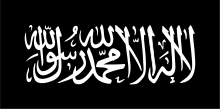- Islamic flags
-
An Islamic flag is a flag that complies with Islamic rules. Traditionally Islamic flags were of solid colour. The most favoured colours were black, white, red and green. However, other plain colours can be adopted. A bi-colour or tricolour (triband) flag can also be adopted as an Islamic flag. An example of a traditional solid coloured Islamic flag would be the old flag of Libya under Gaddafi.
Contents
Early history
Early Islamic flags
Flag with The Shahada and moon (original shape of banner, etc., unknown)The early Muslim community did not use any designs or geometric shapes as symbols on their flags. During the time of the Islamic prophet, Muhammad, Muslim armies and caravans flew simple solid-coloured flags (generally black or white) for identification purposes. In later generations, the Muslim leaders continued to use a simple black, white, or green flag with no markings, writings, or symbolism on it.
Muhammad used flags of different colours in different Ghazwat (or campaigns commanded by Muhammad himself) and Saraya (or campaigns commanded by any Sahaba (the companions of Muhammad). The major flag of Muhammad was known as Al-Uqab (The Eagle); it was pure black, without symbols or markings.[1] Its name and colour was derived from the flag of the Quraysh, an Arabian tribe, whose flag, also called Al-Uqaab, was black with an eagle.[2]
Crescent moon and star
 A typical presentation of the star and crescent.
A typical presentation of the star and crescent.
It wasn't until the Ottoman Empire that the crescent moon and star became affiliated with the Muslim world. Legend holds that the founder of the Ottoman Dynasty, Sultan Osman I, had a dream in which the crescent moon stretched from one end of the earth to the other. Taking this as a good omen, he chose to keep the crescent and make it the symbol of his dynasty. There is speculation that the five points on the star represent the Five Pillars of Islam, but this is pure conjecture. The five points were not standard on the Ottoman flags, and it is still not standard on flags used in the Muslim world today.
The Ottomans also used a flag with a crescent. When the first Ottoman Caliph, Selim I assumed power, the religious flag and the national flag were separated.[1] While both flags featured a right facing crescent, the national flag was red and the religious flag green, and, at a later date a five-pointed star was added.[1] This type of flag has become the de facto Islamic flag, and is used, with variations, by multiple Muslim lands such as Algeria, Azerbaijan, the Comoros, Malaysia, Maldives, Mauritania, Pakistan, Tunisia, Turkey, Turkmenistan, the Turkish Republic of Northern Cyprus, Uzbekistan, and the Western Sahara.[1] As the crescent and star have no religious significance however, some Muslim scholars are against attaching these signs on mosques and minarets or using them to denote Muslim societies.
The Pan-Arab flag and colours
Traditionally, early Arab flags were of one colour only, usually black or white, and charged with a religious inscription. It is thought that Muhammad himself used such flags, and it is said that his followers fought under a white flag.
White was also traditionally the colour of the Umayyad Dynasty.[1] The Abbasid Dynasty which succeeded them used a black flag.[1] The Fatimid Dynasty of caliphs, meanwhile, had green as their traditional colour,[1] while the Hashemites used red.
In 1911, at a meeting in Istanbul, it was decided that a modern flag to represent all Arabs should include all four of these colours. Three years later, al-Fatat (the Young Arab Society), decreed that a future independent Arab state should use a flag of these colours, and on May 30, 1917 Hussein bin Ali, Sharif of Mecca, leader of the Hejaz Revolt replaced his plain red flag with one horizontally striped in black, green, and white with a red triangular area at the hoist. This was seen as the birth of the pan-Arab flag.
Since that time, many Arab nations, upon achieving independence or upon change of political regime, have used a combination of these colours in a design reflecting the Hejaz Revolt flag. These flags include the current flags of Iraq, Syria, Yemen, Egypt, Kuwait, United Arab Emirates, Jordan, Palestinian National Authority, Algeria, and Sudan, and former flags of Iraq and Libya.
Other Arab or predominantly Muslim nations have kept single colour flags, often with some symbol or script. These flags include those of Libya, Turkey, Tunisia, Turkmenistan, Morocco, and Saudi Arabia. Pakistan's flag can also be considered alongside this group.
 New flag of Iran after 1979.
New flag of Iran after 1979.
Where a symbol is used, most frequently it is the star and crescent. Script takes one of two forms, either the Shahada or Allahu Akbar ("God is great"). Iraq uses the pan-Arab colours with the addition of Allahu Akbar—in recognizable form on Iraq's flag. Saudi Arabia and Afghanistan use the Shahadah, a declaration of faith: lā ilāha illā-llāh, wa muħammadan rasūlu-llāh in Arabic, translation "There is no god but Allah and Muhammad is His Prophet".
Representation of flags
Unlike the practice in most Western nations, flags are usually depicted in Islamic countries with the staff to the right. This is analogous to the right-to-left form of most Arabic and Arabic-influenced scripts. This can make for confusion when flag images are shown without an accompanying flagstaff, as it may not be immediately obvious which way around the flag is being depicted.
In keeping with Islamic law, Muslim flags generally do not bear any representations of live creatures, though some Arab flags have the Eagle of Saladin that are used as supporters on the Coats of Arms. These flags are not necessarily Islamic in their nature; rather they more likely to derive from the Pan-Arabist movement. It is rare to find plants depicted on flags of Muslim nations, even though this is permissible under Islamic guidelines. Some state and royal flags of Saudi Arabia depict palm trees.
Islamic extremism
Main article: Black flag of JihadThe Taliban replaced their solid white flag with a white flag inscribed with the shahada in black as they took power in Afghanistan in 1997. Political Islamism and Islamic terrorism has been using black flags inscribed with the shahada in white since ca. 2001.
During the 2000s, it became popular in Islamist jargon to refer to the black flag as al-raya and the white flag as al-liwa', after the terms of the black and white flags flown by Muhammad according to the hadith. The white flag is sometimes identified as the "flag of the Caliphate" while the black one is dubbed the "flag of Jihad".[3]
See also
References
- ^ a b c d e f g The Flags of the Islamic Era
- ^ The Flag of Quraish
- ^ blackflags1.blogspot.com (August 2010)
External links
- Islamic flags at Flags of the World
- Crescent Moon: Symbol of Islam? (islam.about.com)
Categories:- Vexillology
- Islamic culture
- Religious flags
Wikimedia Foundation. 2010.






